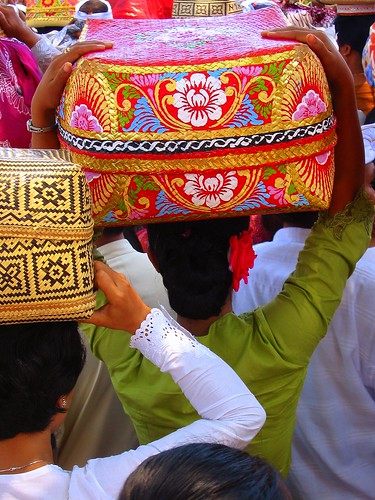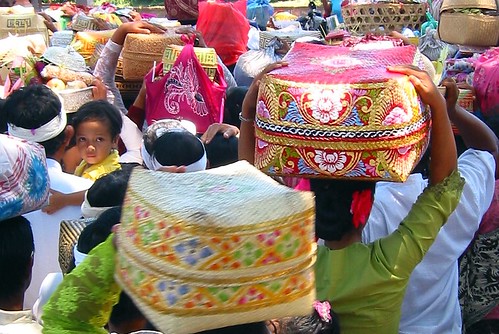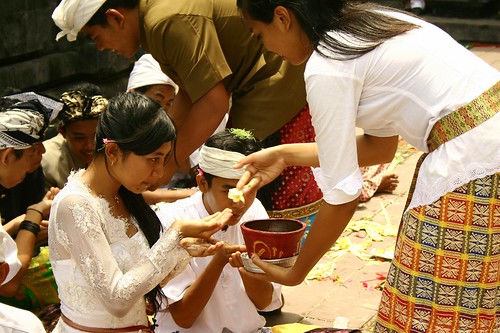Ulian Macekan Agung
Having been going to Bali for 13 years, I have been to numerous ceremonies already like the ngaben or cremation and other traditional commemorations, all of which are in public places. It was my first time however to be invited by my two closest Balinese friends to a ceremony that gains you entry inside the temple- the holy Ulian Macekan Agung ceremony no less. While temple courtyards and gardens are open to tourists, the inner gates leading to the actual shrines are off limits to non-Balinese Hindus, unless you intrude of course. The occasion was the long 10-ten day celebration between the Galungan, the biggest holiday in the Balinese calendar (about 12 months x 35 days) and the Kuningan. The temple was in Gelgel, Klungkung, the central temple for the Pasek Balinese clan.
Taking pictures without standing out was an ordeal. I fit right in for I was just any other brown Asian in Balinese attire but I was torn between capturing the images and the rituals of the shrines (there are 3 courtyards with gates until you get into the inner sanctum courtyard) and feeling guilty for the intrusion. The least obstrusive opportunity to take photos was when the almost thousand teeming masses jostled their way through the narrow three pairs of Balinese gates. In the push to get inside, I think nobody paid notice to one intimidated Filipino raising his camera up in the air, praying that one shot will capture the intimate procession.
a rush of offerers in Pura Gelgel, Klungkung, Bali, Indonesia
Queueing inside the temples of Bali is customary. The sea of humanity attending the ceremony had to participate in several exercises of patience to profess their living faith.
Ceremonies often start early in the morning and depending on how big the celebration- and the Ulian Macekan Agung is- it can last well into late afternoon. People are ushered into batches of about a several hundreds each time. Once your group is allowed into the next shrine enclosure, another group is allowed inside the previous one. Inside the first 2 courtyards, there is really no rituals except the wait for the turn to get inside the 3rd and final innermost shrine.
Inside the three courtyards of the Balinese temple, all you have to do is wait and wait. Nothing happens much until you get inside the innermost shrine. I was surprised too- I originally thought that there are some rituals you perform as you gradually get ushered inside but no, you just mill around anything. Some chatter, some even sleep. As I waited for our turn to get inside the 3rd and penultimate courtyard, I was fascinated by how people automatically segregate themselves according to gender. I guess this boy is considered neuter- yeah age does that to you.
Once inside the innermost courtyard, a series of chanting and prayers were heard. The worshippers, with incense sticks and food offerings, would take the heed of the priests and sit cross-legged. They would bow on occasions, and recite prayers in unison. I did not really feel like intruding some more and refrained from taking pictures. The ceremony was fairly short – it could be no more than 20 minutes.
Afterwards, the people would be given holy water, dispensed by holy brahmana priests of both sexes in white. Some would be able to partake and drink from glasses or cups, others would just settle with being sprinkled on their heads from bunched palm leaves. Rice would also be distributed. Again, I saw others eating some morsels, though this was rare, but practically everyone would stick some rice grains on their forehead. Apparently, the Balinese you see in public with cooked rice on their temples, just between their eyebrows, most probably came from a blessing of sorts, but not necessarily from the temple though. All throughout the rites, readers of the holy scriptures would recite formal Balinese incantations over loud speakers amidst the rhythmic play of a gamelan.
a sample photo of the distribution of blessed rice and water after a Balinese ceremony, this time, during a Saraswati rites in Goa Lawah, Klungkung
As soon as the worshippers received the dispensation to leave, they began filing out, hustling through designated exits. Once empty, the same cycle was repeated as a new batch would be ushered in. My friends told me this would last the entire day. What started early in the morning would occasionally end the next dawn.
Prayers, obviously, are governed by no clock.






No comments:
Post a Comment